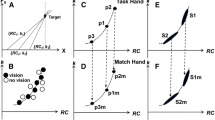Abstract
Three experiments investigated the mechanisms by which we estimate Euclidean distances on the basis of kinaesthetic cues. In all experiments, blindfolded participants followed straight and curvilinear paths with a stylus. Then, with a straight response movement, they estimated the distance between the end-points of the previously explored path. Experiment 1 was designed to validate the hypothesis—made on the basis of results from a previous study—that errors in the kinaesthetic estimations of distances (detour effect) originate from the difficulty to decompose the displacement vector into relevant and irrelevant components, which would become more severe at points of inflection. Using elliptic paths (no inflections), we demonstrated that errors are indeed reduced considerably. The role of the orientation of the work plane was investigated in Experiment 2 in which the same paths used in our previous study were oriented in the frontal rather than the horizontal plane. The results indicate that the detour effect is independent of the orientation. Moreover, despite the asymmetry that gravity introduces between upward and downward movements, errors in the two directions are almost identical. Experiment 3 addressed two issues. First, we demonstrated that introducing a delay between the exploration of the path and the response did not alter significantly the pattern of errors. By contrast, we demonstrated that errors are severely reduced when the number of paths to be explored is reduced by half. The results of the three experiments are discussed within the context of current theories of sensori-motor coding.





Similar content being viewed by others
References
Bryden MP (1977) Measuring handedness with questionnaires. Neuropsychologia 15:617–624
Davidon RS, Cheng MH (1964) Apparent distance in a horizontal plane with tactile-kinesthetic stimuli. Quart J Exp Psychol 16:277–281
Day RH, Avery GC (1970) Absence of the horizontal-vertical illusion in haptic space. J Exp Psychol 83:172–173
Day RH, Wong TS (1971) Radial and tangential movement directions as determinants of the haptic illusion in an L figure. J Exp Psychol 87:19–22
Deregowski J, Ellis HD (1972) Effect of stimulus orientation upon haptic perception of the horizontal-vertical illusion. J Exp Psychol 95:14–19
Faineteau H, Gentaz E, Viviani P (2003) The kinaesthetic perception of Euclidean distance: a study of the detour effect. Exp Brain Res 152:166–172
Gentaz E, Hatwell Y (1995) The haptic “oblique effect” in children and adults’ perception of orientation. Perception 24:631–646
Gentaz E, Hatwell Y (1996) Role of gravitational cues in the haptic perception of orientation. Percept Psychophys 58:1278–1292
Gentaz E, Hatwell Y (1998) The haptic oblique effect in the perception of rod orientation by blind adults. Percept Psychophys 60:157–167
Hogan N, Kay BA, Fasse ED, Mussa-Ivaldi FA (1990) Haptic illusions: Experiments on human manipulation and perception of “virtual objects”. Cold Spring Harbor Symp Quant Biol 55:925–931
Kappers AM (2002) Haptic perception of parallelity in the midsagittal plane. Acta Psychol (Amst) 109(1):25–40
Klatzky RL, Lederman SJ (2003) Representing spatial location and layout from sparse kinesthetic contacts. J Exp Psychol Hum Percept Perform 29(2):310–325
Lederman SJ, Klatzky RL, Barber PO (1985) Spatial and movement-based heuristics for encoding pattern information through touch. J Exp Psychol Gen 114:33–49
Liddle D, Foss BM (1963) The tactile perception of size: some relationships with distance and direction. Quart J Exp Psychol 15:217–219
Paillard J, Brouchon, M (1968) Active and passive movement in the calibration of position sense. In: Freedman SJ (ed) The neuropsychology of spatially oriented behavior. Dorsey Press, Homewood IL, pp 35–55
Rabiner L, Gold B (1975) Theory and application of digital signal processing. Prentice-Hall, Englewood Cliffs, NJ
Rossetti Y, Régnier C (1995) Representations in action: pointing to a target with various representations. In: Bardy BG, Bootsma RJ, Guiard Y (eds) Studies in perception and action III. Lawrence Erlbaum, Mahwah NJ, pp 233–236
Rossetti Y, Gaunet F, Thinus-Blanc C (1996) Early visual experience affects memorization and spatial representation of proprioceptive targets. Neuroreport 7(6):1219–1223
Wilberg RB, Girouard Y (1976) Distance perception affected by retention of the stimuli in short-term memory. Can J Psychol 30(2):63–71
Zuidhoek S, Kappers AM, van der Lubbe RH, Postma A (2003) Delay improves performance on a haptic spatial matching task. Exp Brain Res 149(3):320–330
Acknowledgements
This work was supported by FNRS Grant 31-55620.98 to P.V., Cognitique Program Grant COG 78B (French Ministry of Research) to E.G., and by research funds from UHSR University. We thank the CERN (Geneva) technical services for manufacturing the boards used in the experiments.
Author information
Authors and Affiliations
Corresponding author
Rights and permissions
About this article
Cite this article
Faineteau, H., Gentaz, E. & Viviani, P. Factors affecting the size of the detour effect in the kinaesthetic perception of Euclidean distance. Exp Brain Res 163, 503–514 (2005). https://doi.org/10.1007/s00221-004-2204-7
Received:
Accepted:
Published:
Issue Date:
DOI: https://doi.org/10.1007/s00221-004-2204-7




